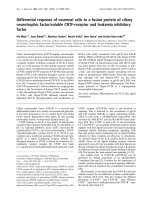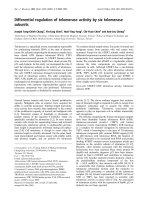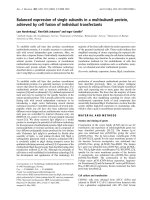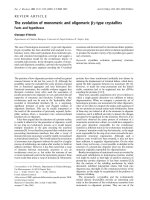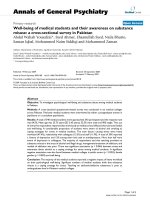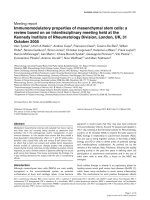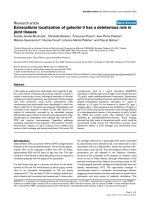Báo cáo y học: "Stigmatising attitude of medical students towards a psychiatry label." pot
Bạn đang xem bản rút gọn của tài liệu. Xem và tải ngay bản đầy đủ của tài liệu tại đây (195.03 KB, 4 trang )
BioMed Central
Page 1 of 4
(page number not for citation purposes)
Annals of General Psychiatry
Open Access
Primary research
Stigmatising attitude of medical students towards a psychiatry label
Olawale O Ogunsemi*, Olatunde Odusan and Michael O Olatawura
Address: Olabisi Onabanjo University Teaching Hospital, Sagamu, Ogun State, Nigeria
Email: Olawale O Ogunsemi* - ; Olatunde Odusan - ;
Michael O Olatawura -
* Corresponding author
Abstract
Background: The aim of this study is to evaluate the effect of a psychiatric label attached to an
apparently normal person on the attitude of final year medical students at a Nigerian university.
Methods: A questionnaire with sections on demographic information, a single-paragraph case
description illustrating a normal person, a social distance scale and questions on expected burden
was used to elicit responses from 144 final year medical students who have had previous exposure
to psychiatric posting. The students consisted of two randomly assigned groups; group A received
a case description with a psychiatric label attached while group B received the same case
description but without a psychiatric label.
Results: A total of 68 (47.2%) of the students responded to the questionnaire with the attached
psychiatric label, while 76 (52.8%) responded to the questionnaire without the attached label.
There was no statistical difference in age (p = 0.187) and sex (p = 0.933) between the two groups
of students. The students who responded to the questionnaire with the attached psychiatric label
would not rent out their houses (p = 0.003), were unwilling to have as their next-door neighbour
(p = 0.004), or allow their sister to get married (p = 0.000) to the man depicted in the case
description compared with those that responded to the questionnaire without label. This group
also felt that the man would exhaust them both physically (p = 0.005) and emotionally (p = 0.021)
in any relationship with him.
Conclusion: These results strengthen the view that stigma attached to mental illness is not limited
to the general public; medical students are also part of the stigmatising world. There is, therefore,
a need to incorporate issues concerning stigma and its reduction as a core component of the
mental health curriculum of medical schools.
Introduction
In most societies mental illness carries a substantial
stigma [1,2]. The mentally ill are often blamed for bring-
ing on their own illnesses, while others may see them as
victims of unfortunate fate, religious and moral transgres-
sion, or even witchcraft. Such stigma may lead to denial
on the part of the family that one of their members is psy-
chiatrically ill. Some families may hide or overprotect a
member with mental illness, thus keeping the person
from receiving potentially effective care.
Stigma remains a powerful negative attribute in all social
relations. It is considered as an amalgamation of three
related problems: a lack of knowledge (ignorance), nega-
Published: 25 August 2008
Annals of General Psychiatry 2008, 7:15 doi:10.1186/1744-859X-7-15
Received: 23 January 2008
Accepted: 25 August 2008
This article is available from: />© 2008 Ogunsemi et al; licensee BioMed Central Ltd.
This is an Open Access article distributed under the terms of the Creative Commons Attribution License ( />),
which permits unrestricted use, distribution, and reproduction in any medium, provided the original work is properly cited.
Annals of General Psychiatry 2008, 7:15 />Page 2 of 4
(page number not for citation purposes)
tive attitudes (prejudice), and exclusion or avoidance
behaviours (discrimination) [3,4].
The mentally ill are labelled as different from other people
and are viewed negatively by others. Stigmatisation can
lower a person's self esteem, contribute to disrupted fam-
ily relationships, and affect employability [5]. It is a bar-
rier to the provision of mental health services by health
planners [6].
Many studies have demonstrated that persons labelled as
mentally ill are perceived with more negative attributes
and rejection regardless of their behaviour [7-9]. Research
has shown that people who are labelled as mentally ill
associate themselves with society's negative conceptions
of mental illness, and that society's negative reactions con-
tribute to the incidence of mental disorder. [10]. How-
ever, other studies have demonstrated that negative
societal reactions are the result, rather than the cause, of
mental illness [11].
Individuals who perpetuate stigma are likely to socially
distance themselves from persons with mental illness.
Social distance may manifest itself in such discriminatory
practices as, for example, not renting property to or hiring
people who have psychiatric disabilities [5,12].
Stigmatising views about mental illness are not limited to
uninformed members of the general public; even well-
trained professionals from most mental health disciplines
subscribe to stereotypes about mental illness [13,14].
Medical students have been shown to have stigmatising
attitudes toward mental illness which they hold onto in
their professional lives [15]. Therefore, research on atti-
tudes toward mental illness, specifically of those in men-
tal health related fields, is necessary to ensure quality care
to persons with mental illness. This is important because
interventions directed at these target groups may be more
cost effective than interventions directed at the general
public [16].
This study aimed to evaluate the effect of a psychiatric
label attached to an apparently normal person on the atti-
tude of final year medical students in a Nigerian univer-
sity.
Methods
This was a cross sectional questionnaire based study con-
ducted among the final year medical students of Olabisi
Onabanjo University, Ogun State. Participation was on a
voluntary basis. A questionnaire containing demographic
information, a single-paragraph case description illustrat-
ing a normal person, a social distance scale and questions
on expected burden was used to elicit response from the
students.
The students were randomly assigned into two groups
using their matriculation numbers. Group A received a
case description with a psychiatric label attached while
group B received the same case description but without a
psychiatric label.
The case description is as follows 'Mr AB is a young man
who can express his feelings and thoughts among those
close to him, although he sometimes gets anxious while
talking in a group consisting of strangers. He gets along all
right with his family most of the time. Generally he also
gets along with other people. Compared to those of his
age, his life can be considered as organised. He is generally
an optimistic and happy person. In summary, he estab-
lishes a good balance between his social life and study'.
The students were assigned to one of the two conditions
of the case description. One condition involved adding
the sentence 'This young man has been diagnosed as hav-
ing mental illness by the doctor who examined him' to the
end of the case description. In the second condition no
psychiatric label was attached to the case description.
Each case description was followed by 16 questions to be
rated on a 4-point scale ranging from definitely agree to
definitely disagree. The questions from 1 to 13 were
designed to measure social distance between oneself and
the person depicted in the case description while ques-
tions 14, 15 and 16 assess the possible burden expected
from a mentally ill person one may associate with. The
case description and the questionnaire were modified ver-
sions of those used in previous studies that concerned psy-
chiatric label and attitude to mental illness [17].
The data derived from the responses of the students were
analysed using SPSS v.10 (SPSS Inc., Chicago, IL, USA).
Results are presented in frequencies and percentages. The
Chi square test was used to determine statistical difference
between proportions while the Student t test was used to
determine the statistical difference between means. A p
value less than 0.05 was considered as statistically signifi-
cant.
Results
A total of 144 students responded to the questionnaire
out of a class of 167. Thus, the response rate was 86.2%.
In all, 81 (56.2%) were males while 63 (43.8%) were
females. A total of 68 (47.2%) of the students responded
to the questionnaire with the attached psychiatric label
(male 55.9%, female 44.1%) while 76 (52.8%)
responded to the questionnaire without the attached psy-
chiatric label (male 56.6%, female 43.4%) (p = 0.933).
The mean (SD) age of the students that responded to the
questionnaire with the attached psychiatric label was
27.07 (3.33) years compared with 26.96 (2.18) years for
Annals of General Psychiatry 2008, 7:15 />Page 3 of 4
(page number not for citation purposes)
those that responded to the questionnaire without the
psychiatric label (p = 0.187).
Table 1 shows the responses of the students to the ques-
tions about the man depicted in the case description. The
students that responded to the questionnaire with the
attached psychiatric label were significantly more unwill-
ing to rent out their houses to the man depicted in the case
description compared to those that responded to the
questionnaire without the attached label (p = 0.003). Sim-
ilarly, they were unwilling to have him as their next-door
neighbour (p = 0.004) or have him as their barber or hair-
dresser (p = 0.000) compared with the group that
responded to the questionnaire without the attached
label. They were also not willing to share an office with
him (p = 0.000) or allow their sister to get married to him
(p = 0.000).
Significantly, the students that responded to the question-
naire with the attached label felt that the man in the case
description will exhaust them both physically (p = 0.005)
and emotionally (p = 0.021) in their relationship with
him, compared with those that responded to the ques-
tionnaire without the psychiatric label.
Discussion
This study set out to investigate the effect of a psychiatric
label attached to an apparently normal person in a case
description on the attitude of final year medical students
toward psychiatrically ill patients. The students have had
previous clinical exposure to psychiatry in the course of
their medical training. The finding in this study indicated
that a label of mental illness on the person depicted in the
case description elicited negative attitude that resulted in
the students wanting to maintain a significant distance
from the person that was labelled mentally ill. The results
provided strong support for the influence of labelling on
certain attitudes. These attitudes were more obvious in cir-
cumstances that could bring a closer relationship between
the respondents and the person depicted in the case
description. They were not willing to have him as their
barber/hairdresser, they would discourage their sister
from planning to get married to him, and they were
uncomfortable with the thought of sharing an office with
him. These findings are consistent with previous studies
on the influence of psychiatric label on attitude towards
mental illness [8,9,17]. Furthermore, the students felt that
friendship with the labelled person would be a burden on
them physically and emotionally. This could further
worsen the social distance between them and the labelled
person. These stigmatising attitudes have been shown to
increase psychological distress in people labelled to be
mentally ill [18]. Moreover such attitudes may inhibit
help seeking among individuals with a mental disorder
[19,20] and provide barriers to their successful reintegra-
tion into the society [21].
The findings in this study provide support for an earlier
report by Adewuya and Makanjuola [22] on the attitudes
of students generally toward the mentally ill in a Nigerian
university. This however, challenges studies where less
stigmatisation of mental illness was reported for non-
Western cultures especially of Asian and African countries
[23,24]. Although a dearth of research on this issue was
given for the observation in these cultures, Fabrega, how-
ever, noted that lack of differentiation between psychiatric
and non-psychiatric disorders in non-Western cultures
could be an important factor for less stigmatisation
[23,24]. It is however important to note that this study
was conducted in a group of students who are medically
Table 1: responses of the students to the person depicted in the case description
Label attached
frequency, % (n = 68)
No label attached:
frequency, % (n = 76)
p Value
Uncomfortable sitting close to him on public transport 36 52.9 31 40.8 0.144
Disturbed by shopping from a market which he runs 13 19.1 16 21.1 0.774
Willing to let your house to him 39 57.4 61 80.3 0.003
Ill at ease by his working as a gateman at your house 31 45.6 25 32.9 0.112
Disturbed participating in a social gathering to which he has been invited 13 19.1 20 26.3 0.308
Willing to play cards with him at a social gathering 54 79.4 50 65.8 0.087
Willing to chat with him on political matters at a social gathering 41 60.3 49 64.5 0.614
Willing to tell him about your own private problems 19 27.9 27 35.5 0.305
Disturbed by his becoming your next-door neighbour 20 29.4 08 10.5 0.004
Will have my hair cut/styled by him if he was a barber/hairdresser 26 38.2 57 75.0 0.000
Disturbed by working in the same place as him 03 04.1 05 06.6 0.616
Will be worried sharing the same room with him if you work at the same place 34 50.0 12 15.8 0.000
Disturbed by your sister wanting to marry him 49 72.1 28 36.8 0.000
Will be an emotional burden on you in your friendship with him 17 25.0 09 11.8 0.021
Will exhaust your physical energy in your friendship with him 20 29.4 09 11.8 0.005
Your friendship with him will have a negative influence on your mental health 08 11.7 10 13.2 0.884
Annals of General Psychiatry 2008, 7:15 />Page 4 of 4
(page number not for citation purposes)
inclined, and hence they should be able to differentiate
between psychiatric and non-psychiatric disorders.
Although a considerable number of studies have consist-
ently reported improvement in attitude of medical stu-
dents toward psychiatry after clinical exposure [25,26],
follow-up studies on such students have queried the sus-
tenance of the observed improvement in attitude toward
psychiatry over time even before they eventually graduate
from medical school [27]. Thus, the finding of a stigmatis-
ing attitude of the final year medical students in this study
may be a reflection of this decay. The challenge then will
be to find a way of sustaining the initial improvement
reported in the literature. The focus will be to provide a
more cost effective approach of educating the medical stu-
dents on stigma reduction in mental health. This is partic-
ularly important because stigma involves different but
related facets [3,4]. This is however, hindered by deficien-
cies in the mental health curriculum in medical schools
where little or no attention is given to stigma as an issue.
Moreover, the common medical textbooks in psychiatry
fail to devote elaborate attention to issues on stigmatisa-
tion of mental illness.
In conclusion, medical students are not exonerated from
the list of people that express stigmatising attitude toward
the mentally ill. There is therefore the need to equip the
students with more knowledge on stigma reduction in
mental health.
Competing interests
The authors declare that they have no competing interests.
Authors' contributions
OOO conceived the study, and participated in its design,
acquisition, analysis and interpretation of data, and in the
drafting of the manuscript. OO participated in its coordi-
nation, statistical analysis and helped to draft the manu-
script. MOO participated in the design of the study, its
coordination and the draft of the manuscript. All authors
read and approved the final manuscript.
References
1. Crisp AH, Gelder MG, Rix S, Melter HI, Rolands OJ: Stigmatization
of people with mental illnesses. Br J Psychiatry 2000, 177:4-7.
2. Gureje O, Lasebikan VO, Ephraim-Oluwanuga O, Olley BO, Kola L:
Community study of knowledge of and attitude to mental ill-
ness in Nigeria. Br J Psychiatry 2005, 186:436-441.
3. Sartorius N, Schulze H: Reducing the Stigma of Mental Illness.
In Global Programme of the World Psychiatric Association Cambridge, UK:
Cambridge University Press; 2005.
4. Thornicroft G: Shunned: discrimination against people with mental illness
Oxford, UK: Oxford University Press; 2006.
5. Penn DL, Guynan K, Daily T, Spaulding WD, Garbin CP, Sullivan M:
Dispelling the stigma of schizophrenia: What sort of infor-
mation is best? Schizophr Bull 1994, 20:567-574.
6. Rössler W, Salize HJ, Voges B: Does community-based care have
an effect on public attitudes toward the mentally ill? Eur Psy-
chiatry 1995, 10:282-289.
7. Link BG, Cullen F, Struening E, Shrout P, Dohrenwend BP: A modi-
fied labeling theory approach to mental disorders: an empir-
ical assessment. Am Social Rev 1989, 54:400-423.
8. Socall DW, Holtgraves T: Attitudes towards mental illness: the
effects of label and beliefs. Soc Quarterly 1992, 33:435-445.
9. Arkar H, Eker D: Effects of psychiatric labels on attitudes
towards mental illness in a Turkish sample. Int J Soc Psychiatry
1994, 40:205-213.
10. Scheff TJ: Being mentally ill: a sociological theory Chicago, IL: Aldine;
1986.
11. Gove W: Labeling theory's explanation of mentally: an
update of recent evidence. Dev Behav 1982, 3:307-327.
12. Levey S, Howells K: Dangerousness, unpredictability, and the
fear of people with schizophrenia. J Forensic Psychiatry 1995,
6:19-39.
13. Keane M: Contemporary beliefs about mental illness among
medical students: implications for education and practice.
Acad Psychiatry 1990, 14:
172-177.
14. Lyons M, Ziviani J: Stereotypes, stigma, and mental illness:
learning from fieldwork experiences. Am J Occup Ther 1995,
49:1002-1008.
15. Mukherjee R, Fiahlo A, Wijetunge A: The stigmatisation of psy-
chiatric illness: the attitudes of medical students and doctors
in a London teaching hospital. Psychiatr Bull 2002, 26:178-181.
16. Sartorius N: Fighting stigma: theory and practice. World Psychi-
atry 2002, 1:26-27.
17. Sari O, Arkar H, Alkin T: Influence of psychiatric label attached
to a normal case on attitude towards mental illness. Yeni
Symp 2005, 43:28-32.
18. Link BG, Struening EL, Rahav M, Phelan JC, Nuttbrock L: On stigma
and its consequences: evidence from a longitudinal study of
men with dual diagnoses of mental illness and substance
abuse. J Health Soc Behav 1997, 38:177-190.
19. Wells JE, Robins LN, Bushnell JA, Jarosz D, Oakley-Browne MA: Per-
ceived barriers to care in St Louis (USA) and Christchurch
(NZ): reasons for not seeking professional help for psycho-
logical distress. Soc Psychiatry Psychiatr Epidemiol 1994, 29:155-164.
20. Corrigan P: How stigma interferes with mental health care.
Am Psychol 2004, 59:614-625.
21. Corrigan PW, Edwards AB, Green A, Diwan SL, Penn DL: Prejudice,
social distance, and familiarity with mental illness. Schizophr
Bull 2001, 27:219-225.
22. Adewuya AO, Makanjuola RO: Social distance towards people
with mental illness amongst Nigeria university students. Soc
Psychiatry Psychiatr Epidemiol 2005, 40:865-868.
23. Fabrega H: Psychiatric stigma in non-Western societies. Compr
Psychiatry 1991, 32:534-551.
24. Ng CH: The stigma of mental illness in Asian cultures. Aust NZ
J Psychiatry 1996, 31:382-90.
25. Tan SM, Azmi MT, Reddy JP, Shaharom MH, Rosdinom R, Maniam T,
Ruzanna ZZ, Minas IH: Does clinical exposure to patients in
medical school affect trainee doctors' attitudes towards
mental disorders and patients? A pilot study. Med J Malaysia
2005, 60:328-337.
26. Galka SW, Perkins DV, Butler N, Griffith DA, Schmetzer AD, Avirra-
ppattu G, Lafuze JE: Medical students' attitudes toward mental
disorders before and after a psychiatric rotation. Acad Psychi-
atry 2005, 29:357-361.
27. Baxter H, Singh SP, Standen P, Duggan C: The attitudes of tom-
morrow's doctors towards mental illness and psychiatry:
changes during the final undergraduate year. Med Educ 2001,
35:381-383.

